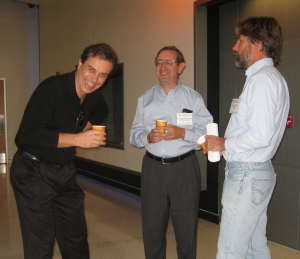Optofluidics Researchers and Industry Representatives Meet To Discuss Future Work
|
San Diego, CA, October 26, 2006 -- The UCSD division of Calit2 cosponsored and hosted the Optofluidics Translational Research and Commercialization Workshop last Friday at Atkinson Hall. The invitation-only meeting brought together researchers affiliated with the DARPA Center for Optofluidic Integration and industry representatives interested in this newly emerging field.
"This is an exciting multidisciplinary area, integrating optics, fluidics, biology, and electronics, that may have a tremendous potential for numerous applications," said Calit2 academic participant Shaya Fainman, a professor in the UCSD Jacobs School of Engineering's Electrical and Computer Engineering department. Optical information systems and their integration is a major thrust of his research lab, the Ultrafast and Nanoscale Optics Group.
Fainman is also a coprincipal investigator of the DARPA Center for Optofluidic Integration which sponsored the workshop. The center is a collaborative project between the California Institute of Technology (Caltech), Harvard University, Stanford University and UC San Diego. It is located at Caltech and funded by the Defense Advanced Research Projects Agency (DARPA). Begun in 2004, the research partnership intends to lay the foundations in this emerging technology by developing a new generation of small-scale, highly adaptable, and innovative optical devices.
|
Optical information systems are used in a wide array of military and civilian applications for imaging, spectroscopy, communications, sensing and displays. Optofluidics is the marriage of optics, optoelectronics and nanophotonics with fluidics. It refers to a class of adaptive optical circuits that integrate optical and fluidic devices. This integration represents a new approach which enables flexible fine-tuning and even dynamic reconfiguration of optical circuits.
Optofluidic integration will ultimately lead to powerful new tools for a broad range of applications in information processing and sensors (including those used in medicine). The DARPA Center has already developed an optofluidic microscope which could revolutionize the diagnosis of certain diseases, such as malaria. With no lens elements and an optofluidic microscope chip the size of a quarter, the palm-sized device will have resolution and magnifying power on par with top-quality traditional glass microscopes. Being able to take the microscope to the sample, perform the analysis on the spot -- however remote that may be -- and begin appropriate treatment will have a tremendous effect on health care, across the globe.
The workshop had a special focus on biomedical applications, although numerous issues are similar in other uses, such as Homeland Security and Department of Defense applications. Participants examined the role of optofluidics in biomedical sensing and instrumentation. The goal was to identify major research and development directions, as well as begin discussions on potential collaborations. As industry presenter Harvey Kasdan, the chief scientist at IRIS Diagnostics, succinctly put it on his final slide: "What can we do together?"
The morning of the one-day workshop was divided into two parts; during the first, the DARPA researchers from the Optofluidic Integration Center presented on their research. "It's an overview of the field for invited industry guests," explained Sindy Tang, an engineering and applied sciences Ph.D. student at Harvard; she presented the work of the George Whitesides Research Group.
Later in the morning, invited industry representatives presented their work and their needs. The industry participants included GE, IRIS, Scripps, Invitrogen, BD Technologies, Illumina, Celula, and the Optoelectronic Industry Development Association. The afternoon was open for discussions and explorations.
As Joseph Beechem, vice president and chief science officer of Invitrogen, stated: "We have the reagents, we know the biology, but we are not good at the design and fabrication of devices; it is good to work with those who are. We think these devices will change biomedical science and we want to help that effort."
|
The director and principal investigator of the Optofluidics Center, Demetri Psaltis, opened the meeting. As he presented a slide depicting the coprincipal investigators and their different areas of expertise, he noted: "In the beginning, different people worked on separate fields, microfluidics, optics and biosensors. Now, everyone is involved in all aspects of optofluidics." Psaltis is also a professor of electrical engineering at Caltech. The cross-disciplinary nature of optofluidics reflects the philosophy of Calit2.
The academic path of DARPA attendee Jerrod Schwartz has followed an evolving multi-disciplinary course to arrive in this new field. "First I got a B.S. in biochemistry, then an M.S. in biophysics," said Schwartz, "now I am a Ph.D. graduate student in bioengineering at Stanford." He works in Stephen Quake's Group and presented on their work.
"This is fantastic," commented Bob Kain, the vice president of engineering at Illumina, during the break after the academic research overview. "You look at what was done and it's very clever and sometimes obvious; but to have invented it in the first place, that takes a leap of creativity."
Related Links
DARPA Center for Optofluidic Integration
Center Affiliated Researchers
Defense Advanced Research Projects Agency (DARPA)
Ultrafast and Nanoscale Optics Group (Fainman)
California Institute of Technology (Caltech)
Harvard University
Stanford University




